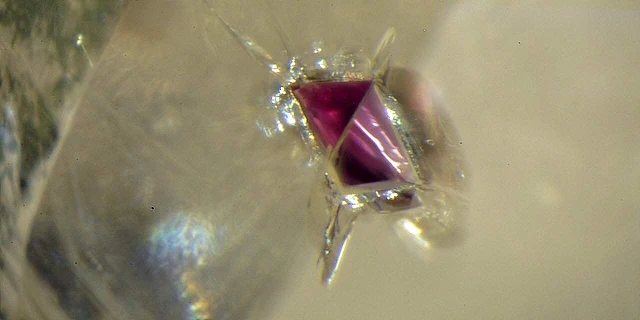Study Identifies Lherzolite as a Source Rock for Diamond Deposits
 |
| Lherzolitic garnet inclusion inside a diamond collected from the De Beers Group Victor Mine. Photo courtesy of Anetta Banas. |
A startling discovery has the potential to change diamond exploration in Canada and around the world.
Research by geologists from the University of Alberta and De Beers Group, the world's largest diamond company, showed that "economic" diamond deposits can come from lherzolitic diamond substrates, a common rock type in Earth's mantle, which until now had only been peripherally associated with diamond formation.
"The outcome of the project fundamentally changes our understanding of where diamonds come from," said U of A geologist Thomas Stachel, the Canada Research Chair in Diamonds. "(It) has the potential to cause diamond companies to retool their approach to exploration."
Diamonds in ancient continental regions, such as the Canadian Shield, were thought to have grown mainly in different types of mantle rocks. The assumption, which has guided exploration for decades, is now being turned on its head.
The research group dated and analyzed the makeup of diamonds, their minuscule inclusions and the mantle itself, said Stachel, who is also director of the Canadian Centre for Isotopic Microanalysis.
"The level of detail collected in this study couldn't be done anywhere else in the world," he said, referring to U of A analytical facilities in which almost $30 million has been invested to enable scientists to probe the age and origins of diamonds at the micro-analytical level.
Stachel said the research results for the Victor Mine could apply to other regions around the world that experienced geologically "young" overprint, in particular in Western Canada.
"In the long run, this could make a big difference in diamond exploration," he said.
The world's diamond industry is worth an estimated $13 billion annually. Canada is home to the world's third largest diamond industry, at $2 billion.
The above story is based on materials provided by University of Alberta.







%20(1).webp)
